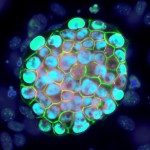Link to Pubmed [PMID] – 24875805
PLoS ONE 2014;9(5):e98507
Maintenance of cell survival is essential for proper embryonic development. In the mouse, Notchless homolog 1 (Drosophila) (Nle1) is instrumental for survival of cells of the inner cell mass upon implantation. Here, we analyze the function of Nle1 after implantation using the Meox2(tm1(cre)Sor) mouse that expresses the Cre recombinase specifically in the epiblast at E5.5. First, we find that NLE1 function is required in epiblast cells, as Nle1-deficient cells are rapidly eliminated. In this report, we also show that the Meox2(Cre) transgene is active in specific tissues during organogenesis. In particular, we detect high Cre expression in the vertebral column, ribs, limbs and tailbud. We took advantage of this dynamic expression profile to analyze the effects of inducing mosaic deletion of Nle1 in the embryo. We show that Nle1 deletion in this context, results in severe developmental anomalies leading to lethality at birth. Mutant embryos display multiple developmental defects in particular during axial skeletal formation. We also provide evidence that axial defects are due to an increase in apoptotic cell death in the somite at E9.5. These data demonstrate an essential role for Nle1 during organogenesis and in particular during axial development.
